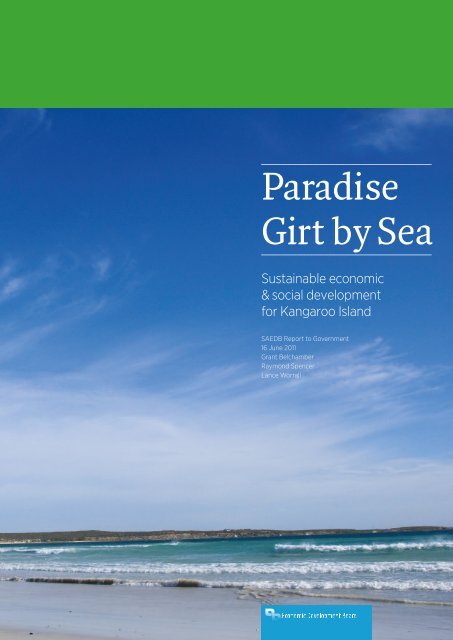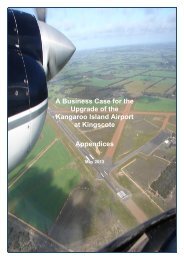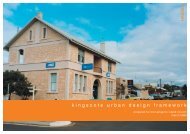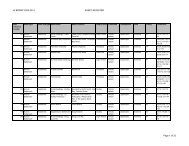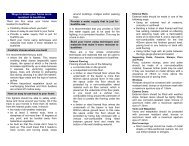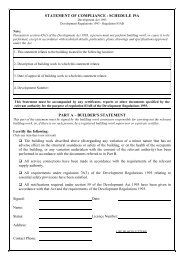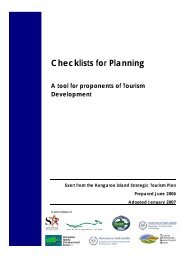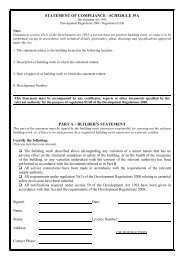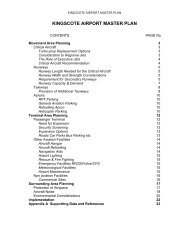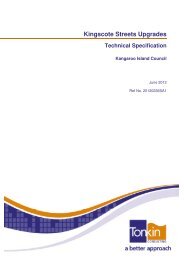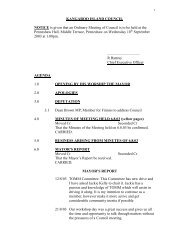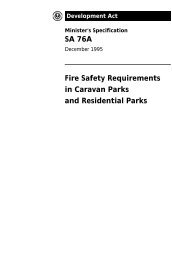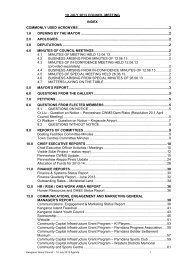Paradise Girt by Sea - Kangaroo Island Council
Paradise Girt by Sea - Kangaroo Island Council
Paradise Girt by Sea - Kangaroo Island Council
You also want an ePaper? Increase the reach of your titles
YUMPU automatically turns print PDFs into web optimized ePapers that Google loves.
<strong>Paradise</strong><br />
<strong>Girt</strong> <strong>by</strong> <strong>Sea</strong><br />
Sustainable economic<br />
& social development<br />
for <strong>Kangaroo</strong> <strong>Island</strong><br />
SAEDB Report to Government<br />
16 June 2011<br />
Grant Belchamber<br />
Raymond Spencer<br />
Lance Worrall<br />
1
Contents<br />
Section Title Page<br />
1 What’s the problem? 4<br />
2 What is to be done? 6<br />
3 Pieces in the puzzle 8<br />
3.1 Five Year Plan 10<br />
3.2 <strong>Kangaroo</strong> <strong>Island</strong> Futures Authority 12<br />
3.3 Skills 14<br />
3.4 Environment and Planning 15<br />
3.5 Farming 16<br />
3.6 Air connection 17<br />
3.7 Roads 18<br />
3.8 Power and telecommunications 20<br />
3.9 Kingscote 21<br />
3.10 <strong>Sea</strong> connection 22<br />
3.11 Penneshaw 26<br />
3.12 Finance and tax 28<br />
3.13 Creating an <strong>Island</strong> Future 32<br />
4 Commitment 34<br />
Appendix About this report 36<br />
3
4<br />
1 What’s the problem?<br />
<strong>Kangaroo</strong> <strong>Island</strong> is a national treasure<br />
Carrying the name of Australia’s distinctive animal, its<br />
international tourist recognition ranks with the Barrier<br />
Reef, Uluru, and the Sydney Opera House.<br />
Its pristine environment and unique natural attractions<br />
make <strong>Kangaroo</strong> <strong>Island</strong> a Mecca for environmental tourism<br />
and bestow on it a natural advantage in production of<br />
clean green foods.<br />
Despite these attributes, economically and socially the<br />
island is languishing. The average age of <strong>Island</strong>ers is higher,<br />
and the average incomes lower, than the rest of the State.<br />
School achievement lags; ‘for sale’ signs are everywhere<br />
across the island.<br />
The causes are chronic, complex, and long-standing:<br />
• The cost of inputs to production and the cost of<br />
delivering goods to market are higher for <strong>Kangaroo</strong><br />
<strong>Island</strong> than for mainland producers;<br />
• Infrastructure exhaustion and bottlenecks abound – top<br />
of the list in need of overhaul and upgrade are the airport<br />
and runway; high-star accommodation; power supply<br />
and distribution network; and the island’s road network;<br />
• The SEALINK ferry provides a reliable but expensive<br />
service;
• KI <strong>Council</strong> revenue is stretched with a small ratepayer<br />
base and conflation of responsibility for provision of<br />
municipal services and tourist infrastructure;<br />
• Administration and delivery of state government services<br />
is fragmented.<br />
• With just 4,500 KI residents, the local services industry<br />
struggles to achieve viable scale.<br />
Over decades, reports and development plans for the<br />
island have promised much and delivered little. It is a<br />
tribute to islander resilience that so many battle on in the<br />
face of repeated disappointment.<br />
The Economic Development Board believes that <strong>Kangaroo</strong><br />
<strong>Island</strong>’s problems are the State’s problems too. South<br />
Australia’s economic future is bright – a prosperous,<br />
vibrant, sustainable State engaged with the world. In<br />
tomorrow’s global catalogue a thriving KI is an iconic<br />
State emblem; an enticing, alluring attraction showcasing<br />
the good life.<br />
We neglect <strong>Kangaroo</strong> <strong>Island</strong> at our peril.<br />
5
6<br />
2 What is to be done?<br />
We believe <strong>Kangaroo</strong> <strong>Island</strong>’s chronic,<br />
complex development challenge can<br />
only be addressed with a coherent,<br />
clear-headed plan backed <strong>by</strong> the<br />
commitment to see it through.<br />
It would be better to do nothing than to generate hopes<br />
with well-intentioned words and fail to follow through with<br />
deeds to match.<br />
A coherent plan is one that addresses each of the main<br />
issues that is holding the island back while retaining the<br />
distinguishing character of the island that gives it its<br />
special appeal.<br />
A clear-headed plan is one that sets realistic, achievable<br />
targets and timelines. It is also one that can be<br />
implemented efficiently and effectively, cutting through<br />
administrative red tape and bureaucracy.Commitment<br />
to the plan - from the State government and from the<br />
<strong>Kangaroo</strong> <strong>Island</strong> community – is absolutely critical to its<br />
success. This means that the plan must be affordable<br />
to South Australian taxpayers, and it must have<br />
overwhelming endorsement and support from island<br />
residents.<br />
The administrative region encompassed <strong>by</strong> a KI<br />
development plan is readily defined – the island is girt<br />
<strong>by</strong> sea. The island is perfectly suited for ‘joined-up<br />
government’, for coordinating and consolidating the<br />
fragmented powers of the separate state government<br />
departments and local government, in and through a<br />
single decision-making Authority answerable to a single<br />
senior Minister.<br />
Any development plan for KI should operate for a defined<br />
period of time, and any special Authority established<br />
to implement it should subject to a sunset provision.<br />
A coherent and clear-headed plan will be expected to<br />
achieve its purpose on time and within budget.<br />
As we see it, there are many pieces in the puzzle that a<br />
<strong>Kangaroo</strong> <strong>Island</strong> Futures Authority (KIFA) will have before<br />
it, to sort out within five years<br />
Summary of<br />
Recommendations<br />
Headline<br />
• Two headline targets under a Five Year Plan:<br />
- Double tourist numbers within a decade; and<br />
- Double farm-gate incomes within a decade.<br />
• Establish a <strong>Kangaroo</strong> <strong>Island</strong> Futures Authority (KIFA) <strong>by</strong><br />
Regulation or Legislation.<br />
• KIFA to fund and manage the Tourism Optimisation<br />
Management Model for the next 5 years
Skills, Environment and Planning<br />
• Integrate whole-of-life education on KI under Director of<br />
<strong>Island</strong> Education.<br />
• Establish KI College of Excellence based on Hospitality,<br />
Tourism and Environmental Management as its<br />
foundation, with local and national/international<br />
students, to be operational within five years.<br />
• Frequent formal and informal collaboration between<br />
DENR island senior management and KIFA. Major<br />
planning approval authority to vest in the Minister on<br />
advice from KIFA.<br />
Infrastructure<br />
• <strong>Council</strong> lease the airport to private operator, lengthen<br />
and strengthen the runway, refurbish the terminal.<br />
KIFA to negotiate package of financial support.<br />
• Either designate the sealed road loop a ‘State road’<br />
or provide State funding assistance of equivalent value<br />
to <strong>Council</strong>;<br />
• KIFA and KI <strong>Council</strong> to review local road network;<br />
define 3 categories for local roads;<br />
• KIFA and KI <strong>Council</strong> in conjunction with DTEI investigate<br />
options to reduce the maintenance costs of the unsealed<br />
road network on KI and improve road quality;<br />
• KIFA commission an expert review of all options for<br />
generation and distribution of electric power supply on<br />
KI, to report within 6 months of its establishment; KIFA<br />
to seek community views on options identified; make<br />
specific recommendations to the Minister within<br />
3 months of receiving the report;<br />
• KIFA to have charge of progressing development<br />
proposals for the Kingscote wharf site; Minister exercise<br />
major project approval powers with respect to the site.<br />
Ferry service<br />
• Charges for SEALINK freight and passenger services<br />
between Cape Jervis to Penneshaw to be subject to<br />
price control.<br />
• The models for price control and the mechanism for<br />
monitoring and enforcing the pricing should be reviewed<br />
within twelve months <strong>by</strong> an independent authority and<br />
at three yearly intervals thereafter.<br />
• KIFA to support construction of new terminal and related<br />
facilities for SEALINK operations at Penneshaw.<br />
• New lease for Lot 89 should be granted with expiry date<br />
as for existing leases.<br />
• Lease extension to be considered and determined not<br />
later than end 2020.<br />
Financial<br />
• Establish KIFA and provide a budget of $25 mn over five<br />
years to deliver the projects outlined in this report.<br />
• No tourist levy on ferry services.<br />
• Consideration of a 5 year moratorium on Land Tax and<br />
Conveyancing Duty.<br />
7
8<br />
3 Pieces in the puzzle
A plan for social and economic development<br />
of KI must build on its established and<br />
inherent strengths.<br />
A plan for social and economic development of KI must<br />
build on its established and inherent strengths.<br />
Decent jobs and good incomes might encourage island<br />
kids to stay on the island when they finish school, or come<br />
back once they’ve seen the world. Decent jobs and good<br />
incomes will encourage people to come to KI and bring<br />
their families, to live and work for a few years or longer.<br />
Economic growth is only worth having if it delivers more<br />
decent jobs and better incomes.<br />
Quite obviously, those decent KI jobs and good KI incomes<br />
depend wholly on maintaining and preserving the island’s<br />
wilderness and wildlife; its un-spoilt solitude; its clean<br />
island pure environment. Too many people (tourists and<br />
residents) too soon could imperil the very environmental<br />
amenity that makes the island so appealing. That said,<br />
<strong>Kangaroo</strong> <strong>Island</strong> is a big place with very few people; if<br />
every person on earth was given one square metre, the<br />
planet’s entire population would fit on it.<br />
Farming and tourism are the engines of today’s KI<br />
economy, and they are its future. Farming is more capital<br />
intensive; tourism and related services are more job rich<br />
per unit of value added. Tourism affords a special form of<br />
direct marketing for island farmers; pure island product<br />
draws tourists. Where KIFA can help coordinate and<br />
facilitate work to improve the integration of farming with<br />
growth of tourism, and to cement and raise the integrity of<br />
the <strong>Kangaroo</strong> <strong>Island</strong> brand, it should do so.<br />
We think the body of work to be achieved <strong>by</strong> KIFA, to<br />
the benefit of both tourism and farming, amounts to a<br />
complete overhaul of economic and social infrastructure<br />
on the island within 5 years. The benefits - more good<br />
sustainable jobs and higher incomes for islanders - should<br />
be well established within a decade.<br />
9
10<br />
3.1 Five Year Plan<br />
A fixed-term plan with clear central targets gives a clear<br />
line of sight to the island’s future.<br />
We propose a Five Year Plan (FYP) targeting:<br />
• a doubling in the number of tourists to KI within<br />
a decade; and<br />
• a doubling in KI farm-gate incomes within<br />
a decade.<br />
These targets build on today’s economic strengths. Their<br />
achievement is constrained <strong>by</strong> today’s infrastructure<br />
bottlenecks, tomorrow’s global economic realities, and<br />
the essential need to preserve the island’s unique defining<br />
character.<br />
The ultimate goal of the FYP is to raise sustainably the<br />
quality of life for <strong>Kangaroo</strong> <strong>Island</strong> residents and their<br />
children. Both targets we propose are directed to this end.<br />
Mindless pursuit of profitless volume in tourist numbers, or<br />
seeking to boost <strong>Island</strong> farm-gate incomes without regard<br />
to environmental impact, would jeopardize achievement of<br />
the ultimate goal.<br />
The substantial infrastructure program we propose is<br />
directed to improving the sustainable social and economic<br />
condition of <strong>Kangaroo</strong> <strong>Island</strong> residents and to preserving<br />
the quality of a premier South Australian tourist asset. Our<br />
consultations have encouraged us in the view that this is<br />
what <strong>Island</strong>ers want.<br />
In our judgment, most or all of the key infrastructure<br />
pieces in the KI puzzle are capable of being completed<br />
within five years, with a pay-back period of three to five<br />
years on the State’s investment.<br />
Double the number of<br />
tourists within a decade<br />
Doubling the number of tourists equates roughly to<br />
doubling the jobs and incomes on KI associated with<br />
tourist services if the average tourist income and length of<br />
stay remains unchanged. A doubling of the average length<br />
of stay for the same number of tourists would have similar<br />
impact. KI tourists include backpackers, working families,<br />
and (some very) high wealth characters; if the additional<br />
tourists have higher incomes than today’s tourists do, the<br />
benefits in jobs and income terms will be greater still.<br />
Of the 185,000 visitors to the island annually,<br />
approximately one-third are internationals, almost half<br />
are South Australians, and almost one quarter are from<br />
interstate. The internationals come for the wildlife and<br />
wilderness; interstaters come for the peace and quiet;<br />
South Australians come for the fishing and to visit friends<br />
and family. Most residents of Adelaide have never been to<br />
the island.
Both the number of tourists, and the number of tourist<br />
nights spent on the island, are potential candidates for<br />
a cogent tourism target. Heads are easier to count than<br />
incomes or length of stay. There is considerable variance in<br />
the number of nights tourists spend in the island.<br />
On balance, we think a doubling of tourist numbers within<br />
a decade is a simple, sound, sensible, headline target.<br />
Within this, an increase in the share of higher-income<br />
tourists (and in the average duration of their stay) will raise<br />
further the yield in island jobs and incomes.<br />
Many of the additional tourists will be (South) Australians;<br />
the exchange rate of the Australian dollar will shape the<br />
composition of the cohort of additional international<br />
tourists. While backpackers will make up some of the<br />
increased numbers, the dividend for the <strong>Kangaroo</strong> <strong>Island</strong><br />
economy will be greater the higher is the share of visitors<br />
seeking and willing to pay for a quality island experience<br />
rather than budget tour groups on day trips.<br />
The Tourism Optimisation Management Model (TOMM)<br />
provides a rich source of data relevant to maximizing the<br />
<strong>Island</strong>’s return from tourism. We think KIFA should provide<br />
funding support to TOMM for the next 5 years and work<br />
with SA Tourism Commission and KI <strong>Council</strong> to ensure the<br />
data it provides is utilised to best effect in pursuit of the<br />
tourism target.<br />
We consider proposals seeking a subsidy for ferry<br />
passenger fares, in section 3.10 below.<br />
Double farm-gate incomes<br />
within a decade<br />
Much of the dividend from a substantial overhaul and<br />
upgrade of KI infrastructure will and should accrue to<br />
island farmers.<br />
We think it appropriate that this also be captured in a<br />
separate headline target under the Five Year Plan.<br />
Improvement in road quality, in availability and reliability of<br />
electric power, and better definition and recognition of the<br />
<strong>Kangaroo</strong> <strong>Island</strong> brand, provide a platform for raising the<br />
incomes of <strong>Island</strong> farmers and tourist operators alike.<br />
Recommendations<br />
Target a doubling in both tourist numbers and farm-gate<br />
incomes within a decade under a Five Year Plan.<br />
KIFA to fund and manage the Tourism Optimisation<br />
Management Model for the next 5 years<br />
11
12<br />
KI <strong>Council</strong><br />
Major Projects<br />
3.2 <strong>Kangaroo</strong> <strong>Island</strong> Futures Authority<br />
Municipal Services<br />
Rates<br />
Waste Management<br />
Water and Wastewater<br />
Cemeteries<br />
Fire Prevention<br />
Library<br />
Local roads and footpaths<br />
Parks and Gardens<br />
Food Premises<br />
Building Regulations<br />
Minor Planning Approvals<br />
($5 mn)<br />
We believe responsibility for implementing a social and<br />
economic development plan for KI should vest in a single<br />
Authority reporting directly to a single high-level Minister.<br />
KIFA Illustrative structure and scope<br />
KIFA Board<br />
Chair EDB<br />
CE dept (DP nominee)<br />
Mayor, KIC<br />
Private sector<br />
Private sector<br />
CEO KIFA (ex officio)<br />
Social Services<br />
Schools<br />
TAFE<br />
Hospital and Health<br />
Deputy Premier<br />
Attorney General<br />
Minister for Justice<br />
Minister for Urban Development,<br />
Planning and the City of Adelaide<br />
Minister for Tourism<br />
Minister for Food Marketing<br />
KI Futures<br />
CEO<br />
2-3 staff<br />
Fractured and fragmented authority, and poorly defined<br />
areas of responsibility, will undermine prospects for<br />
success of any plan.<br />
Business Services<br />
Roadside vegetation<br />
<strong>Kangaroo</strong> <strong>Island</strong> Branding<br />
Business development<br />
Heritage Management<br />
National Parks<br />
Conservation Parks<br />
Tourist Infrastructure<br />
Camp grounds<br />
<strong>Sea</strong>led Roads (other than town<br />
roads)<br />
4WD Roads<br />
Boat Launch
Presently, responsibility for matters affecting the social<br />
and economic development of KI is spread across more<br />
than half a dozen state government Ministers and the KI<br />
<strong>Council</strong>. Communication with federal government agencies<br />
is similarly splintered. For the plan to be effective, this<br />
must be rectified.<br />
Given the central importance of tourism to the island’s<br />
future prospects, we think KIFA should report to the<br />
Deputy Premier. Under present Ministerial arrangements,<br />
the Deputy Premier is also Minister for Tourism, Minister<br />
for Food Marketing, Attorney General and member of<br />
ExComm. This constellation of responsibilities covers<br />
much (though not all) of the territory to be covered <strong>by</strong><br />
the Five Year Plan.<br />
In essence, our recommendation is for KIFA to be the<br />
agency responsible for giving effect to South Australia’s<br />
Strategic Plan on <strong>Kangaroo</strong> <strong>Island</strong>. In discharging its<br />
functions it should have regard to and operate within the<br />
broad parameters of the <strong>Kangaroo</strong> <strong>Island</strong> Plan (released<br />
in January 2011 as a volume of the South Australian<br />
Planning Strategy), as well as the Strategic Infrastructure<br />
Plan for South Australia, and the Natural Resources<br />
Management Plan.<br />
KIFA should work collaboratively with KI <strong>Council</strong> and all<br />
agencies having service delivery functions on the island.<br />
Delivery of municipal services, should remain with KI<br />
<strong>Council</strong>. This includes water supply, which although not<br />
mentioned explicitly in this report, is recognised as an<br />
issue requiring medium term consideration <strong>by</strong> KIFA in the<br />
context of achieving the targets<br />
KIFA should be a lean team with a fixed life. It should<br />
carry responsibility for implementing the ‘major project’<br />
infrastructure initiatives of the Plan; for coordinating<br />
line agencies’ delivery of relevant island services; and<br />
for ensuring the provision and maintenance of tourist<br />
infrastructure. In discharging its functions KIFA exercises<br />
a coordinating and purchasing role; it is not a service<br />
delivery agency in its own right.<br />
KIFA’s work and budget should be overseen <strong>by</strong> a small<br />
high-level Board comprising the Mayor of KI <strong>Council</strong>, a<br />
Departmental CEO nominated <strong>by</strong> the Minister, an EDB<br />
member, and up to two persons with high-level private<br />
sector experience. We think it vital that the KIFA Board is<br />
small, focused and expert. Its success will be determined<br />
principally <strong>by</strong> the quality of the people appointed.<br />
In principle, KIFA could be established <strong>by</strong> Regulation or<br />
<strong>by</strong> specific Legislation. Examples of the latter include the<br />
Sydney Harbour Foreshore Authority in NSW (established<br />
under the Sydney Harbour Foreshore Authority Act 1998)<br />
and the Docklands Authority in Victoria (established<br />
under the Docklands Act 1991). We believe KIFA should be<br />
established as soon as possible, with clear functions and<br />
powers. The most appropriate foundation for KIFA should<br />
be determined forthwith <strong>by</strong> the relevant Minister.<br />
Recommend<br />
Establish KIFA <strong>by</strong> Regulation or Legislation<br />
13
14<br />
3.3 Skills<br />
The social dividend from higher rates of sustainable<br />
economic growth comes overwhelmingly from more<br />
decent jobs with good pay.<br />
Education and skills training is the surest way for KI’s<br />
workers and their kids to win the new jobs and gain a fair<br />
share of that dividend.<br />
Improving and integrating the delivery of education and<br />
training on KI must be a central pillar of the Five Year Plan.<br />
Building on recent initiatives<br />
implemented <strong>by</strong> the<br />
Principal of KI Community<br />
Education, we believe the<br />
island’s education offering<br />
should be fully integrated<br />
from pre-school through<br />
post-secondary and<br />
vocational course provision.<br />
The Youth Strategy for KI, already in existence, provides a<br />
model for youth programs to act collaboratively in order to<br />
address youth issues in a more coordinated, effective and<br />
efficient manner. KIFA should lend its support to the Youth<br />
Strategy for KI.<br />
<strong>Kangaroo</strong> <strong>Island</strong> offers an ideal integrated location for<br />
delivering vocational and further education in hospitality,<br />
tourism and environmental management, including as<br />
residential and work experience placements. In conjunction<br />
with an established mainland institution options should be<br />
explored to offer modular units in full or partial completion<br />
of a certificate, diploma or degree, for both Australian and<br />
international students.<br />
A Director of <strong>Island</strong> Education should be empowered with<br />
functional authority for delivery of pre-school, primary,<br />
secondary, and post-secondary public-funded course<br />
offerings on KI. The Director would work closely with the<br />
CEO of KIFA; with relevant state government departments<br />
and agencies including DECS, DFEEST, and TAFE; with one<br />
or more universities; with DENR; and with local industry.<br />
KIFA should work with the Director of <strong>Island</strong> Education to<br />
facilitate the establishment of a post-secondary College<br />
of Excellence in hospitality, tourism and environmental<br />
management. Figure 1 shows education as a service<br />
responsibility of KIFA; this does not mean that the Director<br />
and education staff are employed <strong>by</strong> KIFA, but that they<br />
operate in conjunction with and carrying the authority<br />
of KIFA. Teachers remain employed <strong>by</strong> the education<br />
department.<br />
A further proposal presently in development contemplates<br />
establishment of a marine research capability on <strong>Kangaroo</strong><br />
<strong>Island</strong>. In collaboration with some South Australian<br />
universities and local interests, a steering committee<br />
chaired <strong>by</strong> Professor Robert Hill of Adelaide University has<br />
been convened with a view to establishing a <strong>Kangaroo</strong><br />
<strong>Island</strong> Marine Scientific Research Institute. Should this<br />
embryonic proposal come to fruition it would complement<br />
the proposed College of Excellence. We think KIFA should<br />
engage with the proponents of this initiative.<br />
More island workers with up-to-date relevant skills means<br />
delivery of a better island tourist package. It also means<br />
better jobs and incomes. A cohort of resident students<br />
and researchers, drawn to the island and refreshed each<br />
semester or year, means more life and vitality and a larger<br />
market for island retail outlets.<br />
Recommend<br />
Integrate whole-of-life education on KI under Director of<br />
<strong>Island</strong> Education<br />
Establish KI College of Excellence based on Hospitality,<br />
Tourism and Environmental Management as its foundation,<br />
with local and national/international students, to be<br />
operational within five years.
3.4 Environment and Planning<br />
Without its pristine splendor, KI really does not have much<br />
to offer the world beyond isolation and a trip back in time.<br />
Uninhabited before European settlement, for 175 years<br />
<strong>Kangaroo</strong> <strong>Island</strong> has combined large scale farming of<br />
crops and livestock, with extensive preservation of a<br />
unique natural environmental and untouched coastline.<br />
Today the island remains free not only of rabbits and<br />
foxes, but also of genetically modified crops. It is home<br />
to the world’s purest strain of Ligurian bees, introduced<br />
to the island <strong>by</strong> sealers in the first half of the 19th century.<br />
It provides sanctuary to platypus, native to Australia but<br />
introduced to the island.<br />
Almost one-third of the island is national or conservation<br />
park. The true uniqueness of the <strong>Kangaroo</strong> <strong>Island</strong><br />
environment lies in the balance it maintains between<br />
human presence and the integrity of its natural<br />
endowment.<br />
A development plan which has at its core the maintenance<br />
and preservation of KI’s environmental amenity stands<br />
a real chance of growing better jobs and incomes<br />
sustainably for many years. A plan which neglects and<br />
diminishes the island’s inherent environmental advantage<br />
is really not a development plan at all.<br />
These days, <strong>Sea</strong>l Bay, Flinders Chase, the lighthouses and<br />
conservation parks are well managed and maintained<br />
<strong>by</strong> rangers and officers employed <strong>by</strong> the Department of<br />
Environment and Natural Resources. It ain’t broke; it does<br />
not look like breaking; we do not recommend fixing it. But<br />
new challenges will arise and will need to be resolved <strong>by</strong><br />
KIDA and DENR working closely together at all levels.<br />
We do strongly recommend close collaboration between<br />
KIFA and DENR Management on <strong>Kangaroo</strong> <strong>Island</strong>. A<br />
doubling of tourist numbers means twice as many visitors<br />
through the classic island destinations. Capacity issues<br />
will arise around power supply, accommodation, roads,<br />
water, waste, and other issues. Clear and early sharing of<br />
information between KIFA and DENR island management<br />
will help identify pressure points and necessary responses<br />
in a timely way.<br />
There is also tremendous scope to integrate and engage<br />
island rangers and park management in development<br />
and operation of the proposed post-secondary College<br />
of Excellence. Intimate liaison between KIFA, the Director,<br />
and senior DENR officials will be essential to the success<br />
of the College and ensure that benefits also flow from the<br />
College to environmental management.<br />
The challenge of doubling tourist numbers and farm<br />
gate incomes within a decade will require that new<br />
major project proposals (including civil engineering and<br />
commercial developments) are determined expeditiously<br />
consistent with the <strong>Island</strong> Plan. We think a clear and<br />
certain approvals track for such projects is essential. The<br />
process must allow for community consultation and expert<br />
assessment, and be completed within tight timeframes.<br />
Final decision on proposals should vest in the Minister on<br />
advice from KIFA.<br />
Recommend<br />
Frequent formal and informal collaboration between DENR<br />
island senior management and KIFA<br />
Major planning approval authority to vest in the Minister on<br />
advice from KIFA<br />
15
16<br />
3.5 Farming<br />
Farming has been the<br />
mainstay of KI’s economy for<br />
the past hundred years and<br />
more. It has been estimated<br />
that the farmers of the 350<br />
farms on <strong>Kangaroo</strong> <strong>Island</strong><br />
have collectively invested<br />
between $1.2 - $1.3 billion<br />
dollars.<br />
Things grow well on KI and its seas are pristine and<br />
plentiful, but the watergap means island pure product<br />
must get a premium on price to earn a just return. Plain<br />
old bulk commodity will always struggle against mainland<br />
producers, struggle to get <strong>by</strong>.<br />
Considerable work has been undertaken towards a<br />
common branding for island product, and some significant<br />
success achieved. This work should continue and be<br />
supported under a KI plan; it has been and must be driven<br />
principally <strong>by</strong> island producers working together.<br />
As a corollary, assuring the provision and reliability of<br />
supply of agricultural product to target markets – on the<br />
island and on the mainland - is vital. This was put to us<br />
in sharp relief with the following example. To feature “KI<br />
prime lamb” on their menus and shelves, restaurants and<br />
retailers on KI must source the cuts from abattoirs on the<br />
mainland as there is no facility on the island. Typically<br />
at present, KI lamb goes to Normanville for processing<br />
before returning to the island for retail supply, giving it a<br />
significant price handicap in the local market.<br />
The major infrastructure initiatives we propose for roads<br />
and power will support growth of farm-gate incomes on<br />
the <strong>Island</strong>. KIFA should coordinate and support business<br />
extension initiatives, drawing on programs and services<br />
provided through state and federal governments.<br />
The cost of freight is a major issue for <strong>Island</strong> farmers.<br />
Relative to mainland producers, farmers must pay more<br />
to bring fuel, fertilizer and other inputs to the farm and to<br />
ship product to mainland markets. The additional freight<br />
costs are inherent in doing business on the <strong>Island</strong>. A<br />
standing freight subsidy to offset this cost differential in<br />
whole or in part would necessarily be paid <strong>by</strong> mainland<br />
taxpayers. The inherent cost disadvantage will also<br />
be offset to the extent that a price premium can be<br />
commanded, derived from differentiating <strong>Island</strong> from<br />
similar mainland product.<br />
We return to the freight subsidy issue in section 3.10 below.
3.6 Air connection<br />
The current state of the<br />
<strong>Kangaroo</strong> <strong>Island</strong> airport<br />
near Kingscote stands in the<br />
way of a doubling of tourist<br />
numbers to KI within a<br />
decade.<br />
The runway is too short and too soft to accommodate<br />
aircraft with seating capacity greater than the 34 seat<br />
SAAB 340 turbo prop aircraft that currently service the<br />
island. The small private and corporate jets carrying<br />
passengers (mostly headed for the Southern Ocean<br />
Lodge) have hard narrow tyres that damage the runway<br />
surface.<br />
The airport lounge was last refurbished in 1988 and is not<br />
set up for security screening. Passengers with connecting<br />
flights to and from the island can not check their baggage<br />
through Adelaide airport but must collect and re-check it<br />
through security in Adelaide.<br />
The number of aircraft passenger movements between<br />
Adelaide and Kingscote, which includes tourist and other<br />
visits, has fallen over the past decade from 91,000 in 1999<br />
to 52,500 in 2010.<br />
Investors proposing to build more four and five star<br />
accommodation on the island are unable to factor in<br />
sufficiently high occupancy rates in their financing models,<br />
because air traveler numbers are constrained <strong>by</strong> aircraft<br />
capacity limits. This limits achievable rates of return on<br />
their investment and raises the cost of finance.<br />
A target to double KI tourist numbers within a decade,<br />
and especially to increase the share of high-income<br />
international tourists to the island, can not be achieved<br />
with the present runway and lounge facilities at the airport.<br />
It is critical if the targets in the FYP are to succeed, that<br />
the airport runway is lengthened and strengthened to<br />
accommodate a broader range of aircraft types and<br />
capacities.<br />
Presently, the airport is owned and operated <strong>by</strong> KI <strong>Council</strong>.<br />
The investment required to undertake the runway and<br />
terminal work is beyond <strong>Council</strong>’s financial capacity, which<br />
is already stretched in meeting the current level of service.<br />
We think the airport should be leased long-term <strong>by</strong><br />
<strong>Council</strong> to a private airport operator (such as Adelaide<br />
Airport Corporation) with the financial capacity and<br />
operational expertise to undertake the necessary runway<br />
and terminal investments and to operate the airport.<br />
On present tourist numbers, anticipated rates of return<br />
on these investments are too low for a private operator<br />
to proceed with them. The equation changes somewhat<br />
under the proposed FYP. Given the crucial importance<br />
of the airport to achieving the plan’s target, KIFA should<br />
provide financial support to ensure the essential airport<br />
upgrades proceed forthwith.<br />
Recommend<br />
• <strong>Council</strong> lease the airport to private operator<br />
• Lengthen and strengthen the runway<br />
• Refurbish the terminal<br />
• KIFA to negotiate package of financial support<br />
17
18<br />
3.7 Roads<br />
Most of the island’s road network is unsealed; and under<br />
current arrangements its maintenance is a major and<br />
possibly unsustainable financial burden on KI <strong>Council</strong>.<br />
In general, the State government has responsibility<br />
for maintaining ‘state roads’ and local councils have<br />
responsibility for ‘local roads’. A ‘state road’ is one that<br />
connects two towns.<br />
There are four towns on KI, and none south or west of<br />
Parndana. However KI’s premier and renowned tourist<br />
attractions (<strong>Sea</strong>l Bay, Flinders Chase, Admirals Arch,<br />
Remarkable Rocks) are all south and west of Parndana.<br />
The vast proportion of traffic on the roads south and west<br />
of Parndana is accounted for <strong>by</strong> tourists, as is much of the<br />
traffic on the north coast roads and the Dudley peninsula.<br />
<strong>Council</strong>’s road maintenance budget comes from island<br />
ratepayers and is supplemented <strong>by</strong> federal government<br />
assistance grants. Much of the wear and tear on island<br />
roads is caused <strong>by</strong> tourists. If this ratio of tourists to<br />
residents were replicated for a comparable area on the<br />
plains of Adelaide, some 40 million tourists annually would<br />
use the road network from Victor Harbour to Gawler, from<br />
the coast to Mt Barker.<br />
This situation is not<br />
sustainable now, and unless<br />
present arrangements are<br />
changed the burden on<br />
island ratepayers will rise<br />
sharply if tourist numbers<br />
double within a decade.<br />
This situation has been identified in the recent 2011-2012<br />
State Budget with, “registration fees for motor vehicles will<br />
increase slightly above inflation to raise an extra $2 million<br />
every year to fund extra road resurfacing and rehabilitation<br />
works to improve the condition of South Australia’s<br />
regional road networks. <strong>Kangaroo</strong> <strong>Island</strong> will be the first<br />
beneficiary of this measure.”<br />
We think the road network on KI needs to be reviewed<br />
and responsibility for its maintenance recast. KIFA and KI<br />
<strong>Council</strong> should engage with DTEI as a matter of priority, to<br />
review the road maintenance program on the island and<br />
explore all options to reduce costs and improve the quality<br />
of the unsealed road network.<br />
The special case of KI, with Flinders Chase situated<br />
at the far south-western corner of the island, should<br />
be recognized. One option is for the sealed road loop<br />
(Birchmore Road, South Coast Highway, West End<br />
Highway) to be designated a State Road. This would have<br />
federal road funding implications. An alternative is for DTEI<br />
to provide maintenance funding for the shortfall between
federal funding and the full cost of maintaining the loop.<br />
There is also a case for DENR contributing to these<br />
maintenance costs. While we do not express a preference<br />
between these options, we believe the case is compelling<br />
for <strong>Kangaroo</strong> <strong>Island</strong> ratepayers to be relieved of the cost of<br />
maintaining the sealed road loop.<br />
With a couple of possible caveats, we do not think a major<br />
program to extend the sealed road network on the island is<br />
necessary or warranted. Unsealed roads graded regularly<br />
meet the needs of resident farmers. A substantial cohort of<br />
tourists to KI brings their 4-wheel drive vehicles to access<br />
remote areas through difficult terrain. Part of the attraction<br />
of KI is its ‘underdone’ wild character. For these tourists,<br />
‘less is more’; the island would lose much of its inherent<br />
appeal were the entire KI road network sealed. That said,<br />
the unequivocal evidence from the TOMM survey is that<br />
the single biggest and overwhelmingly material drawback<br />
of the KI experience cited <strong>by</strong> tourists is the condition of the<br />
roads. In time and subject to resources, the North Coast<br />
road, and the road to Cape Willough<strong>by</strong> from Penneshaw,<br />
are clearly prime candidates for sealing.<br />
We think KIFA should engage with KI <strong>Council</strong> in reviewing<br />
the island’s municipal road network with a view to<br />
designating all island roads (other than the ‘State roads’ as<br />
discussed separately) in three distinct categories:<br />
1. Town roads (within town boundaries servicing residential<br />
and commercial needs);<br />
2. Local roads (all-weather roads suitable for 2-wheel drive<br />
vehicles; and<br />
3.Remote roads (4-wheel drive only, for accessing remote<br />
island areas).<br />
Following detailed review with KIFA and DTEI, KI <strong>Council</strong><br />
should specify the maintenance program applying to each<br />
local road category, and structure its road maintenance<br />
budget accordingly. The maintenance budget and program<br />
for Remote roads should be negotiated between KI<br />
<strong>Council</strong> and KIFA.<br />
Recommend<br />
Either designate the sealed road loop a ‘State road’ or<br />
provide State funding assistance of equivalent value to<br />
<strong>Council</strong>;<br />
KIFA and KI <strong>Council</strong> to review local road network;<br />
define 3 categories for local road; KIFA and KI <strong>Council</strong> in<br />
conjunction with DTEI investigate options to reduce the<br />
maintenance costs of the unsealed road network on KI and<br />
improve road quality.<br />
19
20<br />
3.8 Power and telecommunications<br />
<strong>Kangaroo</strong> <strong>Island</strong> is connected to the national electricity<br />
grid through a 10MW submarine cable from Cape Jervis<br />
to Penneshaw. This cable is second generation, the<br />
original cable having failed through normal aging. KI is<br />
on the end of a long distribution line extending from the<br />
Torrens <strong>Island</strong> power station. The present cable is old and<br />
nearing the end of its functional life. We were advised that<br />
the cable is not capable of carrying power in the other<br />
direction; the current submarine cable is incapable of<br />
feeding power generated on KI back into the national grid.<br />
A proposal to upgrade the submarine cable was recently<br />
rejected <strong>by</strong> the Australian Energy Regulator (AER). ETSA<br />
is planning a new submission to the AER that is likely to<br />
include replacement and extension of the existing cable<br />
from 2016.<br />
From Penneshaw a high transmission line extends the<br />
length of the island with two stepped reductions in the<br />
voltage carried. West and south of Parndana electricity<br />
is distributed through a single line (SWIR - single wire<br />
earth return). There is some back-up diesel generation<br />
capacity for the island network located in Kingscote, but<br />
these can only operate continuously for three week blocks<br />
before requiring maintenance. To repair or replace the<br />
undersea cable, if it were to fail within Backstairs passage,<br />
is estimated at 12 months.<br />
Diesel self-generation is endemic on the island, on some<br />
estimates meeting perhaps half of KI’s electricity needs.<br />
Industry on the western end of the island can not secure<br />
from the grid sufficient power to meet its needs. A timber<br />
mill operation on the island uses 1mn litres of diesel a year<br />
to generate its own power because the grid can not supply<br />
it. One of the reasons given <strong>by</strong> the regulator in rejecting<br />
upgrade of the marine cable was the existing diesel<br />
generating capacity on <strong>Kangaroo</strong> <strong>Island</strong>.<br />
It is hard (if not impossible)<br />
to reconcile KI’s clean green<br />
pristine stamp, with the<br />
island’s heavy continuing<br />
reliance on diesel generation<br />
to meet its electricity needs.<br />
We think the situation is critical. The chronic and pervasive<br />
lack of sufficient reliable power needs a coherent, efficient,<br />
long-term solution. All options (including replacement and<br />
upgrade of the submarine cable) will entail significant new<br />
investment. Given the age of existing infrastructure and<br />
the cost of inaction, an island solution must be found soon.<br />
We think KIFA should commission an expert review of all<br />
options available to <strong>Kangaroo</strong> <strong>Island</strong> to meet its current<br />
and future requirements for electricity, and deliver its<br />
report within 6 months of its establishment. An extensive<br />
review recently conducted <strong>by</strong> Regional Development<br />
Australia into the issues of electrical power generation<br />
distribution and supply for <strong>Kangaroo</strong> <strong>Island</strong> should inform<br />
the proposed review.<br />
This review should identify the cost of and carbon<br />
emissions produced <strong>by</strong> alternative generation options,<br />
including upgrades to or modification of the island<br />
distribution network. It should have regard to the Five Year<br />
Plan and consider:<br />
• Early replacement of the submarine cable, including<br />
possible KI generation and supply into the national grid;<br />
and<br />
• stand-alone supply, with no submarine cable and<br />
complete separation of the island from the national grid.<br />
All generation options under the stand-alone model should<br />
be considered, including diesel, biomass, solar and wind.<br />
The Review should consider both centralized generation<br />
and dispersed small- and micro-generation alternatives,<br />
and the implications of these for the island distribution<br />
network. It should make recommendations regarding the<br />
priority and sequencing of any interventions.<br />
We think it appropriate that KIFA should make the Report<br />
publicly available (save for any commercially sensitive<br />
content) and seek the views of the island community.<br />
Within 3 months of receiving the Report, KIFA should<br />
make specific recommendations to the Minister regarding<br />
the supply of electricity on <strong>Kangaroo</strong> <strong>Island</strong>.<br />
Presently, mobile phone and internet access is slow or<br />
non-existent on much of the island. This is a drawback<br />
for many islanders, and a serious constraint for island<br />
businesses and international tourists alike. Investigating<br />
options to improve telecommunications connectivity and<br />
coverage on KI should be within scope of KIFA’s functions.<br />
Recommend<br />
KIFA commission an expert review of all options for<br />
electric power supply and distribution on KI, to report<br />
within 6 months of its establishment;<br />
KIFA seek community views on options identified;<br />
Make specific recommendations to the Minister within 3<br />
months of receiving the report.
3.9 Kingscote<br />
If the Five Year Plan is endorsed and adopted, Kingscote<br />
will grow strongly.<br />
Much or most of the additional accommodation capacity<br />
needed to house a doubling of tourist numbers within a<br />
decade will be located in Kingscote. It is a convenient hub<br />
for day trips to all parts of the island.<br />
Accommodating many or most of the additional tourists<br />
in the island’s established major town is consistent with<br />
preserving the un-spoilt, uncluttered character of the rest<br />
of the island. It also builds critical market size to support a<br />
growing vibrant entertainment precinct and cultural heart<br />
on the island with restaurants and nightlife within walking<br />
distance of a bed.<br />
The Kingscote wharf precinct is a precious and unique<br />
development opportunity. The right development will<br />
provide a fantastic focal point for the town and the<br />
island. The wrong development will be an eyesore and a<br />
headache for decades to come.<br />
We think development of the<br />
Kingscote wharf precinct is a<br />
major project whose success<br />
is an absolutely vital part in<br />
the sustainable social and<br />
economic development of<br />
<strong>Kangaroo</strong> <strong>Island</strong>.<br />
An Expression of Interest process for the site has recently<br />
been conducted, with no proposals of sufficient quality<br />
received.<br />
As a stand-alone commercial project, redevelopment of<br />
the Kingscote Wharf precinct does not rank prominently<br />
amongst the infrastructure initiatives vital to meeting the<br />
twin targets we propose. However, as a mixed use facility<br />
housing a base for the College of Excellence, possibly<br />
the Marine Research Institute, a functional wharf for<br />
leisure, commercial and research craft, some commercial<br />
retail, office and accommodation capacity, along with<br />
community open and meeting space, the precinct offers<br />
interesting and appealing possibilities.<br />
We think KIFA should be asked to prepare concept<br />
proposals for the Kingscote Wharf site consistent with<br />
the Five Year Plan and seek joint venture partners for<br />
appropriate development of the site. In developing<br />
this concept work (and also for the Penneshaw project<br />
outlined below) KIFA should seek input and advice from<br />
the Integrated Design Commission.<br />
The Minister on recommendation from KIFA should<br />
exercise the power to approve (or veto) the development<br />
of Kingscote Wharf precinct.<br />
Recommend<br />
• KIFA have charge of progressing development proposals<br />
for the Kingscote wharf site;<br />
• Minister exercise major project approval powers with<br />
respect to the site<br />
21
22<br />
3.10 <strong>Sea</strong> connection<br />
SEALINK provides a reliable, quality ferry service between<br />
Cape Jervis and Penneshaw, for passengers and freight.<br />
Carrying cars, busses and trucks SEALINK provides today’s<br />
bridge to the mainland, connecting the road networks on<br />
both sides of Backstairs Passage.<br />
The sea connection has always been critical for the people<br />
of <strong>Kangaroo</strong> <strong>Island</strong>, but the Karratta was a seriously slow<br />
service and the Troubridge was a perpetual drain on the<br />
public purse. SEALINK provides the fastest, most reliable<br />
vehicular ferry service the island has ever had, carrying<br />
the bulk of tourist numbers and virtually all freight. And it<br />
turns a good profit.<br />
For island residents especially, the sea connection<br />
provided <strong>by</strong> SEALINK is an essential service; island life<br />
and commerce could barely exist without it. It is also one<br />
displaying the distinguishing characteristics of natural<br />
monopoly. Over many years competing services have<br />
<strong>Sea</strong>link<br />
Cape Jervis to<br />
Penneshaw<br />
<strong>Sea</strong>road<br />
Queenscliff to Sorrento<br />
tried and failed to capture a share of the trade. Scale of<br />
operations is critical with a high capital threshold to enter,<br />
and dedicated docking infrastructure is required at each<br />
terminal.<br />
SEALINK holds long-term leases on property owned <strong>by</strong><br />
the State government and KI <strong>Council</strong>, bestowing on it an<br />
effective concession to provide the service. The current<br />
leases expire in 2025. New leases will be required for a<br />
parcel of reclaimed land adjacent to and contiguous with<br />
the current site, known as Lot 89. Recently, in conjunction<br />
with development plans for the Penneshaw passenger<br />
terminal, SEALINK has sought a 25 year extension of the<br />
operating leases beyond their current expiry.<br />
Prices charged <strong>by</strong> SEALINK do generate some community<br />
disquiet, and for passengers and cars do seem<br />
comparatively high.<br />
Fraser <strong>Island</strong> Barges<br />
River Heads to King<br />
Fisher Bay Resort<br />
Rottnest Express<br />
Fremantle to Rottnest<br />
<strong>Island</strong><br />
Rottnest Fast Ferries<br />
Hillarys to Rottnest<br />
<strong>Island</strong><br />
Trip Distance (km) 16 12 11 19 26<br />
Trip Travelling Time<br />
(mins)<br />
45 40 50 25-30 40<br />
Number of ferries 2 2 2 4 1<br />
Total capacities (both<br />
ferries combined)<br />
Passengers 597 1400 440 1119 300<br />
Cars 108 160 ? N/A N/A<br />
Example 1: 2 adults, 2<br />
children, 1 car, return<br />
Example 2: 2 adults,<br />
2 children (locals), 1<br />
car, return<br />
Example 3: 2 adults,<br />
2 children, no car,<br />
return<br />
$444.00 $148.00 $150.00 N/A N/A<br />
$344.00 N/A N/A N/A N/A<br />
$272.00 $72.00 $150.00 $154.50 $210.00
Some operators of tourist establishments on KI seek a<br />
standing subsidy for passenger movements to and from<br />
the island (for which there is no alternative to the ferry<br />
service), pointing to the provision <strong>by</strong> the State government<br />
of punt services for Murray River crossings at no charge to<br />
users, notwithstanding the availability of bridge crossings.<br />
Of particular concern to KI business and farmers especially,<br />
is the cost of freight.<br />
Primary producers on King and Flinders <strong>Island</strong>s in<br />
Bass Strait receive a freight subsidy from the federal<br />
government; the origin of this subsidy lies in recognition<br />
that the federal government bears the cost of maintaining<br />
the nation’s interstate road network and that, as vehicular<br />
ferry services from the mainland to Tasmania effectively<br />
connect that State to the rest of the nation, the federal<br />
government ought meet a portion of the cost of<br />
maintaining that service. This is the source of the freight<br />
subsidy between Tasmania and the mainland; some years<br />
ago this subsidy was extended to the Bass Strait islands<br />
notwithstanding their being part of Tasmania and thus not<br />
part of the interstate road network.<br />
23
24<br />
This additional cost, for passenger and freight movements<br />
to and from <strong>Kangaroo</strong> <strong>Island</strong>, has been dubbed the<br />
‘Watergap’ and has been costed to be in the order of $4.5<br />
million annually. On grounds of fairness and equity, several<br />
prominent KI individuals and organisations have called for<br />
extension to the island of a standing subsidy – from the<br />
State government for passenger movements and from<br />
the federal government for freight movements. For some,<br />
this is seen as the single most important impediment<br />
to sustained growth of <strong>Kangaroo</strong> <strong>Island</strong> enterprise and<br />
incomes.<br />
To date these calls have not been successful.<br />
We accept the cogency and respect the force of the<br />
‘Watergap’ argument. We also recognize the argument<br />
that standing operational subsidies are problematic; the<br />
cost to government of any per unit subsidy rises with<br />
the volume of traffic; the benefit of the subsidy is expires<br />
coincident with the movement of freight or passengers;<br />
operating subsidies are chronically at risk of abrupt<br />
termination <strong>by</strong> governments perennially seeking to curtail<br />
public expenditure.<br />
Moreover, expenditure of public monies in sound capital<br />
investments promises a more enduring return than an<br />
equivalent amount spent on operating subsidies. It must<br />
also be acknowledge that a substantial proportion of<br />
the benefit from any passenger subsidy would accrue to<br />
non-island resident. If the quantum of resources available<br />
to KI over the next five years were of a magnitude roughly<br />
equivalent to the ‘Watergap’ we believe it would best be<br />
spent on capital projects to the direct and lasting benefit<br />
of KI residents and businesses.<br />
We think SEALINK has a vital part to play in KI’s future
development. The service can readily be scaled up to<br />
accommodate the substantial increase in the number of<br />
passengers and vehicles implied <strong>by</strong> the Five Year Plan. As<br />
a privately owned firm SEALINK requires healthy rates of<br />
return on its investments.<br />
In view of the essential service and natural monopoly<br />
characteristics attaching to the ferry service, there is<br />
a strong case for SEALINK to be subject to annual or<br />
periodic surveillance and review <strong>by</strong> an independent pricing<br />
authority. This would assist community understanding<br />
and acceptance that fares were fair. A regime of price<br />
control presently applies to <strong>Sea</strong>link freight charges. We<br />
understand that negotiations regarding price control for<br />
passenger movements are presently underway and we<br />
urge their early and transparent completion.<br />
Recommend<br />
Charges for SEALINK freight and passenger services<br />
between Cape Jervis to Penneshaw to be subject to price<br />
control. The models for price control and the mechanism<br />
for monitoring and enforcing the pricing should be<br />
reviewed within twelve months <strong>by</strong> an independent<br />
authority and at three yearly intervals thereafter.<br />
25
26<br />
3.11 Penneshaw<br />
Penneshaw is a delightful and historic small town with<br />
a glorious aspect overlooking Backstairs Passage. It is<br />
the main gateway to <strong>Kangaroo</strong> <strong>Island</strong> for SEALINK ferry<br />
passengers, and is also the gateway to the hidden delights<br />
of the Dudley peninsula region.<br />
Penneshaw stands to benefit greatly from growth of<br />
tourism under the Five Year Plan.<br />
The present SEALINK terminal at Penneshaw is a bare<br />
bones affair and something of an eyesore. Located at<br />
the heart of the Penneshaw foreshore area adjacent to<br />
the beachfront shopping strip, it resembles a dilapidated<br />
parking lot. Increased freight and passenger movements<br />
will bring more car and truck traffic to and through the<br />
town, along its foreshore access route to the terminal.<br />
We understand an application for funding under the<br />
Regional Development Infrastructure Fund (RDIF) is<br />
under consideration with a decision imminent on a<br />
State contribution towards construction of a new $3 mn<br />
passenger terminal and related facilities at and adjacent to<br />
the existing SEALINK terminal site.<br />
We think there is merit in KIFA working with SEALINK to<br />
improve facilities at the Penneshaw terminal, and fully<br />
support the provision of State government infrastructure<br />
funding for this purpose. Any RDIF contribution should<br />
be overseen and managed <strong>by</strong> KIFA. We also think input<br />
from the Integrated Design Commission should be<br />
sought to assist KIFA and the local community preserve<br />
the character of the town while accommodating these<br />
changes
A detailed study into the logistical issues of marshalling<br />
trucks to handling the anticipated increase in freight<br />
traffic in a sensible and sensitive manner is required, given<br />
Penneshaw’s location on a seaside knoll and the absence<br />
of flat ground in the immediate vicinity to accommodate a<br />
suitable marshalling facility.<br />
It may also be appropriate to review and the Cape Jervis<br />
port design. This end of the crossing dictates the size<br />
(length) of the vessels that SEALINK can use now and in<br />
the future.<br />
New leases for Lot 89 on the Penneshaw foreshore should<br />
incorporate the same expiry date as the current leases.<br />
To provide sufficient time for sound long-term planning,<br />
further extension of the leases should be considered and<br />
determined not later than end December 2020.<br />
Recommend<br />
• KIFA to support construction of new terminal and related<br />
facilities for SEALINK operations at Penneshaw.<br />
• New lease for Lot 89 should be granted with expiry date<br />
as for existing leases.<br />
• Lease extension to be considered and determined not<br />
later than end December 2020.<br />
• KIFA to commission a study into freight logistics and<br />
implications for Penneshaw’s town character.<br />
27
28<br />
3.12 Finance and tax<br />
This piece of the puzzle has at least three parts. We deal<br />
with them in turn.<br />
KI <strong>Council</strong> financial<br />
sustainability<br />
Though rates charged <strong>by</strong> KI <strong>Council</strong> are at the high end<br />
of the spectrum relative to other similar regional South<br />
Australian councils, its long-term capacity to meet the<br />
maintenance requirements of its municipal assets is<br />
far from assured. Further, new investments required<br />
(for example, to upgrade the Kingscote airport) appear<br />
to be a hill too high and beyond <strong>Council</strong>’s present capacity.<br />
To meet this anticipated funding shortfall, and recognizing<br />
the burden on island ratepayers occasioned <strong>by</strong> wear<br />
and tear of municipal assets <strong>by</strong> tourists, KI <strong>Council</strong> has<br />
investigated options including a tourist levy (notionally<br />
at a rate of $10 per head).<br />
Summary of Total Rates Revenue for 2008/09 Financial Year<br />
Estimated<br />
Resident<br />
Population as at<br />
30 June 2009<br />
(excluding<br />
unincorporated<br />
areas)<br />
Area<br />
(Hectares)<br />
General<br />
Rates ($<br />
000)<br />
Other Rates<br />
($ 000)<br />
We believe that, while imposition of a tourist levy may<br />
be feasible, it would send all the wrong signals under a<br />
Five Year Plan to double tourist numbers within a decade.<br />
We do not support introduction of a tourist levy.<br />
Our recommendations regarding the upgrade and<br />
operation of Kingscote airport, categorical clarification<br />
and administrative partitioning of the island’s road<br />
network, and separation of municipal services from tourist<br />
infrastructure with KI <strong>Council</strong> being responsible for the<br />
former and KIFA for the latter, should significantly relieve<br />
<strong>Council</strong>’s funding pressures within the life of the Plan.<br />
Over time, economic growth occasioned under the Plan<br />
will increase the rates base available to <strong>Council</strong> and<br />
assure its long-term capacity to meet and improve<br />
KI municipal services.<br />
Other<br />
Charges<br />
($ 000)<br />
Rate<br />
Write-offs &<br />
Discretionary<br />
Rebates &<br />
Remissions<br />
($ 000)<br />
Total Rates<br />
($ 000)<br />
Ceduna 3,797 543,306 2,549 762 17 (82) 3,246<br />
Goyder 4,285 668,787 3,285 433 29 (117) 3,630<br />
<strong>Kangaroo</strong> <strong>Island</strong> 4,612 443,438 3,881 2,183 79 (46) 6,097<br />
Lower Eyre Peninsula 4,820 475,524 3,259 644 19 (49) 3,873<br />
Northern Areas 4,866 297,409 2,909 651 23 (111) 3,472<br />
Yankalilla 4,577 75,693 6,220 997 134 (66) 7,285
30<br />
Watergap<br />
By virtue of the need to transport inputs to the island<br />
and ship product back to the mainland, the cost of doing<br />
business on KI will always be higher than comparable<br />
activity on the mainland.<br />
As noted above, this reality has led to some calls for a<br />
standing subsidy to be provided <strong>by</strong> the State to offset the<br />
inherent cost disadvantage of being an island. Cogency in<br />
this argument is gained from recognition that the cost of<br />
punt services across the Murray is met from State revenues<br />
notwithstanding the existence of alternative crossings (ie<br />
bridges), and that federal subsidies are paid for freight<br />
movements to King and Flinders islands in Bass Strait.<br />
For practical and pragmatic reasons, we do not believe a<br />
standing transport subsidy is a viable long-term prospect.<br />
The subsidy required to keep the Troubridge operating<br />
was a factor in its demise. A capitation-based watergap<br />
subsidy would rise with success of the Five Year Plan; a<br />
subsidy for island residents or resident island business<br />
would be administratively cumbersome and fraught.<br />
However we do believe a thriving KI is a vital State<br />
asset, and that a standing policy concession to offset<br />
the watergap is warranted. We think consideration<br />
should be given to making KI free of State Land tax and<br />
Conveyancing Duty for a five year period. This would<br />
deliver an immediate fillip to island residents and business<br />
under a Five Year Plan and ‘prime the pump’ for growth<br />
over the decade to come.<br />
We see no case to exempt KI from the Emergency Services<br />
Levy or Gaming tax. The vast majority of <strong>Island</strong> businesses<br />
are too small to be liable for payroll tax. However the stock<br />
of unsold properties on KI is substantial; exemption from<br />
Land Tax and Conveyance Duty would raise net returns<br />
from sale for <strong>Island</strong>ers seeking to sell their properties,<br />
and lower the cost of purchasing both for <strong>Island</strong> residents<br />
contemplating increasing their holdings and for others<br />
seeking to invest on the <strong>Island</strong>. There would be some<br />
leakage of the immediate benefit to non-island residents<br />
but we suspect this would be substantially less than<br />
would occur with an operating subsidy for freight and<br />
passenger fares.<br />
In weighing the case for a Watergap subsidy, we commend<br />
consideration of this exemption from Land Tax and<br />
Conveyancing Duty alternative. If such an exemption were<br />
granted, we think it should be for a fixed term (five years,<br />
to expire with KIFA) with review of its impact after<br />
three years.
<strong>Kangaroo</strong> <strong>Island</strong> Futures<br />
Authority<br />
KIFA will require funding for its operations and additional<br />
funding for the projects it sponsors and facilitates.<br />
A further question is whether and in what quantum<br />
KIFA should have some asset backing to underpin its<br />
operational standing and authority.<br />
Operational funding for KIFA should be modest. We think<br />
a Chief Executive with two operational staff and one<br />
full-time administrative support should be sufficient to<br />
give effect to the Five Year Plan. With this profile a KIFA<br />
administration budget of less than $1 mn annually for five<br />
years should be well sufficient to meet salaries and oncosts<br />
plus rent and administrative expenses.<br />
Funding for KIFA projects will be a mix of public and<br />
private funding. KIFA should always seek to leverage its<br />
own project contributions with funding from other sources.<br />
KIFA should seek to access and coordinate applications for<br />
Commonwealth grant funding under all possible programs<br />
– regional infrastructure, regional development, solar<br />
flagships, tourism, housing, etc – and similarly leverage<br />
this funding wherever possible through partnerships with<br />
private interests.<br />
KIFA should explore all feasible options for private / public<br />
partnerships.<br />
Our recommendations contemplate some reallocation of<br />
current expenditures, from Agencies to KIFA.<br />
Some indicative projects for KIFA were put to us in<br />
consultations; we supplement these with some judgment<br />
calls of our own, covering:<br />
• Runway lengthening and strengthening<br />
• Airport refurbishment<br />
• Penneshaw terminal<br />
• Consultant report on power options<br />
• Either designate the sealed road loop a ‘State road’ or<br />
provide State funding assistance of equivalent value to<br />
<strong>Council</strong><br />
• Maintenance of 4WD network and minor tourist<br />
infrastructure<br />
• Support for establishment of College of Excellence<br />
• Kingscote wharf consultancy and direct contribution<br />
• Support for TOMM<br />
• Support for Food Branding and business development<br />
supply initiatives and consultancies<br />
• Capacity to support additional initiatives over the life of<br />
the Plan.<br />
Our estimates point to an expenditure of around $25 mn<br />
over 5 years, of which 80% or more is project specific.<br />
Greater precision will be obtained from detailed work to<br />
establish KIFA.<br />
The cost of the proposed “tax-free KI” initiative is separate<br />
and additional. The cost of implementing a sustainable KI<br />
power plan is separate and additional.<br />
Beyond this we believe there is a strong case for KIFA<br />
having some asset backing. In particular, the Kingscote<br />
Wharf precinct is surplus to DTEI requirements and (as<br />
we see it) central to Kingscote’s long-term evolution as an<br />
education and research hub on the island. Transfer of title<br />
to KIFA would greatly facilitate development of the site as<br />
a mixed use facility incorporating educational, research,<br />
community and some commercial activity, fully consistent<br />
with the character of Kingscote and the island’s future.<br />
Recommend<br />
• Establish KIFA and provide a budget of $25 mn over five<br />
years to deliver the projects outlined in this report.<br />
• No tourist levy on ferry services.<br />
• Consideration of a 5 year moratorium on Land Tax and<br />
Conveyancing Duty.<br />
31
32<br />
3.13 Creating an <strong>Island</strong> Future<br />
The long-term viability of a KI accommodating double the<br />
number of current tourists will depend on its capacity to<br />
meet and satisfy their expectations, and the virtuous circle<br />
impact that flows from that.<br />
This puts focus on the island’s ability to provide a complete<br />
tourist package – above and beyond its special tourist<br />
sights.<br />
Off-the-shelf and bespoke tourist packages are presently<br />
provided well <strong>by</strong> some island tour operators. What scope<br />
is there to create additional adventure options that<br />
will appeal to high-income enviro-tourists and South<br />
Australians alike, to keep them on the island active and<br />
happy for a few more days in between a scrumptious<br />
island breakfast and a delectable evening repast?
There is no limit to imagination<br />
The Lighthouse Trail<br />
A walking track from Cape Borda to Cape Du Couedic,<br />
along the coast through Flinders Chase, linking and<br />
integrating current camping facilities. Tasmania has its<br />
world famous ‘South West walk’ and renowned ‘Cradle<br />
Mountain – Lake St Clair’ trail. What would be required<br />
to get the Lighthouse Trail up and operational? Tour<br />
operators could deliver parties to Cape Borda and collect<br />
them from Cape Du Couedic, provision parties for the<br />
trip, provide guides with expert local knowledge and<br />
guaranteed safety.<br />
The North Coast Bike Track<br />
At present KI is not especially bike friendly, yet the<br />
popularity of cycling amongst high-income populations<br />
of Europe and North America is rising dramatically. A<br />
path from Cape Borda to Kingscote along the north<br />
coast would see cyclists with the prevailing westerlies at<br />
their back, routing through Western River Cove, Stokes<br />
Bay, and Emu Bay. Much less expensive than a sealed<br />
road, a north coast bike track could be an unsealed route<br />
suitable for mountain bikes or a sealed path suitable for<br />
street bikes. Bikers could do it all themselves, or purchase<br />
a local package involving overnight accommodation in<br />
tents or lodges, meals, and separate transport of personal<br />
baggage.<br />
D’Estree’s Bay to Vivonne Bay Wilderness<br />
Adventure<br />
Wild, remote, beautiful – a hike through virgin landscape<br />
along raging southern shores.<br />
With support and enthusiasm from DENR, KI locals, and<br />
environmental interests detailed scoping studies into these<br />
and other possibilities could and should be supported <strong>by</strong><br />
KIFA.<br />
33
34<br />
4 Commitment<br />
A Five Year Plan and<br />
empowerment of a KIFA to<br />
see it through will change the<br />
shape of KI while preserving<br />
the <strong>Island</strong>’s unique character<br />
and attributes.<br />
For the Plan to succeed, it is essential that it be welcomed<br />
and receive support from the <strong>Island</strong>’s resident population.<br />
The many pieces in the KI puzzle are connected. We<br />
propose an integrated plan of action to address the array<br />
of complex issues that are inhibiting sustained social<br />
and economic growth on <strong>Kangaroo</strong> <strong>Island</strong>. We think<br />
the measures we have proposed will establish a sound<br />
platform for growing decent <strong>Island</strong> jobs and good <strong>Island</strong><br />
incomes that are sustainable well into the future, beyond<br />
the term of KIFA.<br />
There is no magic wand to be waved, no silver bullet to<br />
be fired, that will deliver sustainable social and economic<br />
development on <strong>Kangaroo</strong> <strong>Island</strong>. Piecemeal measures will<br />
surely fail.<br />
If implemented effectively and efficiently, a package<br />
of measures directed to rectifying the core issues –<br />
power, roads, skills and education, the air and sea ports,<br />
<strong>Council</strong>’s financial sustainability, growing business scale<br />
and preserving the <strong>Island</strong> environmental character – can<br />
establish the robust foundation on which a prosperous<br />
sustainable <strong>Kangaroo</strong> <strong>Island</strong> future can be built.
36<br />
Appendix - About this report<br />
A.1 Origin of the reference<br />
The development challenges facing <strong>Kangaroo</strong> <strong>Island</strong> were<br />
raised <strong>by</strong> Bruce Carter (Chair of the Board) at the EDB<br />
meeting held 16 June 2010.<br />
The Board resolved to establish a sub-committee<br />
comprising Grant Belchamber and Lance Worrall to<br />
make some further inquiries. At the EDB meeting held 16<br />
September 2010, Raymond Spencer agreed to join the<br />
sub-committee.<br />
Meetings held with Premier Rann and Ministers Conlon,<br />
O’Brien, Rau, Caica, Gago and Holloway confirmed<br />
unanimous support for EDB involvement in reviewing<br />
the economic, social and environmental sustainable<br />
development issues on KI.<br />
The sub-committee visited KI on 17/18 October, for<br />
informal inspections of island infrastructure and facilities,<br />
and consultations with KI stakeholders including the Mayor<br />
and CEO of KI <strong>Council</strong>, the island’s school principal, and<br />
business operators.<br />
Further meetings were held in Adelaide with key business<br />
operators and investors with interests in KI, and with the<br />
Member for Finniss, Michael Pengilly.<br />
A Workshop to discuss a range of options under<br />
consideration was held at the Ozone Hotel Kingscote on<br />
Tuesday 24 May 2011. Thirty-two participants including<br />
three EDB members attended the Workshop, which was<br />
chaired <strong>by</strong> Prof Julian Disney.<br />
The sub-committee reviewed a range of papers and<br />
reports that had addressed the development challenges<br />
on KI.<br />
A.2 List - Who we consulted<br />
Ministers and Members of Parliament<br />
• The Premier, Mike Rann<br />
• Patrick Conlon<br />
• Michael O’Brien<br />
• John Rau<br />
• Paul Caica<br />
• Gail Gago<br />
• Paul Holloway<br />
• Michael Pengilly<br />
KI <strong>Council</strong><br />
• Jayne Bates - Mayor<br />
• Carmel Noon/John Coombe - CEO<br />
Other individuals<br />
• Nick Jones & Dean Bagley (SATC)<br />
• Greg Mackie (A/CE DPC)<br />
• Trent Mader (DTED)<br />
• Cathy King (CPR Adelaide)<br />
• John Ipsen (RuralAus Ltd)<br />
• Barry Featherston & Terry Lee (RDA)<br />
• Geoff Rischbieth<br />
• Richard Trethewey (KINRMB)<br />
• Wendy Campana (LGA)<br />
• Andrew Duncan (Ozone Hotel)<br />
• Ian Kent (KI Community Education)<br />
• Pierre Gregor (Tourism KI)<br />
• Craig Wickham (Exceptional KI)<br />
• Ian Drummond & Tim Langmaid (Aurora Hotels/Resorts)<br />
• Phil Baker & Mark Young (Adelaide Airport Ltd)<br />
• Jeff Ellison (<strong>Sea</strong>link)<br />
• Roch van Delft (Qantas)<br />
• Duncan McGillivray (<strong>Kangaroo</strong> <strong>Island</strong> Pure Grains)<br />
• Caj Amadio & Brent Blanks<br />
• Andrew Milazzo, Rick Hennig & Alan Hartley (DTEI)<br />
• Sandy Di Marco<br />
• Helen Lamont (PIRSA)<br />
• Prue Archer (DPLG)
A.3 List of references and<br />
reports reviewed<br />
Type Title Author Prepared for Month Year<br />
Discussion paper 1 <strong>Kangaroo</strong> <strong>Island</strong> EDB Ministers Jul 2010<br />
Fact Sheet 2 SA Water - <strong>Kangaroo</strong> <strong>Island</strong> Long<br />
Term Plan Schedule<br />
Letter 3 Response to letter dated 20 April<br />
2010 <strong>by</strong> Mayor Jayne Bates<br />
Letter 4 Response to leter dated 16 July<br />
2010 <strong>by</strong> Minister Conlon<br />
SA Water Public domain Unknown Unknowm<br />
The Hon Patrick<br />
Conlon MP<br />
News Paper Article 5 “State Shuns <strong>Island</strong>” The <strong>Island</strong>er<br />
newspapaer<br />
Press release 6 KI Long-term Water Security Plan<br />
One Step Closer<br />
Mayor Jayne Bates The Hon Patrick<br />
Conlon MP<br />
Hon Karlene<br />
Maywald<br />
Briefing 7 <strong>Kangaroo</strong> island Traveller’s Levy DTED - OSBRD &<br />
PBE<br />
Mayor Jayne Bates Jul 2010<br />
Aug 2010<br />
Readers Aug 2010<br />
Public domain Aug 2009<br />
Minister for Regional<br />
Development<br />
Briefing 8 <strong>Kangaroo</strong> <strong>Island</strong> Briefing DTED Internal to<br />
Government<br />
Briefing 9 <strong>Kangaroo</strong> <strong>Island</strong> CPR Adelaide -<br />
Cathie King<br />
Brochure 10 <strong>Kangaroo</strong> <strong>Island</strong> - A Great Place<br />
to Invest<br />
Plan 11 Kingscate Aerodrome: Long Term<br />
Strategic Plan<br />
KI Development<br />
Board<br />
Aug 2010<br />
May 2010<br />
Bruce Carter - EDB June 2010<br />
Public domain Mar 2004<br />
KI <strong>Council</strong> Public domain Feb 2010<br />
Plan 12 Kingscate Airport Master Plan KI <strong>Council</strong> Public domain Unknown Unknowm<br />
Plan 13 Kingscote Airport Civil<br />
Infrastructure management Plan<br />
Plan 14 Airport Infrastructure And Asset<br />
Management Plan<br />
Plan 15 Airport Long Term Financial Plan<br />
2011-2020<br />
Plan 16 Kingscote Port Strategic<br />
Development Plan<br />
Tonkin Consulting Public domain Oct 2009<br />
KI <strong>Council</strong> Public domain Nov 2009<br />
KI <strong>Council</strong> Public domain Dec 2009<br />
KI Ports<br />
Management Group<br />
May 2005<br />
Plan 17 Development Plan KI <strong>Council</strong> May 2009<br />
37
38<br />
A.3 List of references and<br />
reports reviewed (cont.)<br />
Type Title Author Prepared for Month Year<br />
Plan 18 <strong>Kangaroo</strong> <strong>Island</strong> Strategic Tourism<br />
Plan<br />
Report 19 An Investigation into the Utilisation<br />
of End User Generation on KI<br />
Report 20 KI Traveller’s Levy Economic<br />
Impact Assessment<br />
Report 21 KI Regional Land Use Framework<br />
- A proposed alteration of the<br />
planning strategy for SA<br />
Report 22 Local Government on <strong>Kangaroo</strong><br />
<strong>Island</strong> Today and Tomorrow<br />
Report 23 <strong>Kangaroo</strong> <strong>Island</strong> Watergap<br />
Recognition Project<br />
Report 24 KI Matters: <strong>Council</strong> works with<br />
State Government for roads<br />
Report 25 Economic Analysis of Road<br />
Funding Options on <strong>Kangaroo</strong><br />
<strong>Island</strong><br />
Report 26 <strong>Kangaroo</strong> <strong>Island</strong> Food, Wine and<br />
Tourism Industry Development<br />
Report<br />
Report 26 <strong>Kangaroo</strong> <strong>Island</strong> Food, Wine and<br />
Tourism Industry Development<br />
Report<br />
ACRONYMS<br />
KIDB <strong>Kangaroo</strong> <strong>Island</strong> Developmment Board<br />
DEH Department for Environment & Heritage (now DENR)<br />
Urban & Regional<br />
Planning Solutions<br />
KI <strong>Council</strong>, KIDB,<br />
Tourism KI, DEH,<br />
KINRMB, SATC<br />
Jun 2006<br />
Wessex Consult Jan 2009<br />
Access Economics KI <strong>Council</strong> Jul 2009<br />
DPLG Mar 2009<br />
JAC Comrie Mar 2008<br />
Meyrick and<br />
Associates<br />
KINRMB <strong>Kangaroo</strong> <strong>Island</strong> Natural Resources Management Board<br />
SATC South Australian Tourism Commission<br />
DTED Department of Trade & Economic Development<br />
OSBRD Office of Small Business & Reginal Development (DTED)<br />
PBE Policy & Business Environment (DTED)<br />
EDB Economic Development Board<br />
<strong>Kangaroo</strong> <strong>Island</strong><br />
Development Board<br />
Sep 2009<br />
KI <strong>Council</strong> Rate payers Aug 2010<br />
Econ<strong>Sea</strong>rch KI <strong>Council</strong> July 2010<br />
Barnett<br />
Communications &<br />
Marketing<br />
Barnett<br />
Communications &<br />
Marketing<br />
March 2010<br />
March 2010


